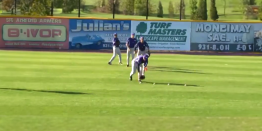| Creating An Effective Baseball Team With Two Outs
Provided By: American Baseball Coaches Association (ABCA)
One of our most important philosophies at MacArthur High School is playing pitch by pitch. We want our players completely focused, both offensively and defensively, every time the ball crosses the plate. Executing "winning pitches" more often than our opponent will consistently put us in a position to win a game, and more specifically, we believe the outcome is determined by just a handful of these pitches. Our goal is to "win" these crucial pitches and to expect success when the ball leaves the pitcher's hands. Often these game-changing pitches come with two outs in the inning. How many times has a team executed an important two-out hit and gone on to win the game? Or not as obvious, how many times would the outcome have changed if that two-out ground ball to the shortstop with runners on second and third was thrown into right field? To accomplish winning these the two-out situations, we developed a game emphasizing "winning the pitch" while creating a competitive environment for our players, and working on our approach to success. A number of games are played during our practices awarding points for putouts and runs scored, or taking or giving up extra bases, but in order to work on the two-out situation, the game is modified. We named the modified game simply, "Two Outs." In this game "Defense 1" is on the field for seven minutes while "Defense 2" is hitting. After the time allotted, teams switch for another seven minutes. Hitters get three pitches or opportunities to "get the job done" simulating a condensed "at-bat." A point is awarded after every hitter throughout the game. For every third out recorded, the defense gets a point, and for every successful trip to the plate the offense earns one. After each third out, the situation is reset, and at the end of 14 minutes, the team with the highest point total earns the victory. During the first minute no one is on base. The offense works on "the two-out rally" while the defense attempts to record the elusive third out. Offensively, we stress, "not trying to do too much," "put the ball in play with authority," and "get on base," - another one of our huge philosophies. For both the offense and the defense getting the job done when called upon on is vital to success throughout the game. During minute two there is a runner at first. The offense is two hits away from scoring a run. Runners must take good secondary leads making sure they make every effort to get to third base. The defense must take care of the ball on a base hit and keep the leading runner at second. Minutes three and four are dedicated to working with a runner at second where more times than not, a base hit scores a run. Defensively, infielders have to keep the ball in the infield. Simultaneously, outfielders must consider if there is going to be a play at the plate. It is imperative to throw the ball through the cutoff man keeping the runner at first, or getting the ball to second base. Offensively, hitters must have a "good approach," driving hittable pitches and laying off enticing ones. They must understand the need to drive in the crucial two-out run, but more importantly, their goal is to get to the next hitter any way they can. In order to achieve this goal, hitters get three pitches. If no strikes are thrown and the hitter successfully lays off, he takes his base, earning a point for the offense for successfully getting to the next hitter. In the fifth through sixth minute runners are at second and third. A walk is not necessarily a negative for the defense, creating a force at any base, but it is considered a "win" for the offense, sending another hitter to the plate. A hit should score two runs, and once the ball reaches the outfield the main priority for the defense is keeping the runner off second base. Taking care of the ball is vital for the defense to avoid the "big inning," and as always, hitters must have a good approach and get a good pitch to hit. Finally, in minute seven we place a runner at third. The pressure to make a play on defense and make effective throws across the field is now at its peak in the infield. The offense knows a base hit scores a run, but as always, the goal is to get to the next hitter. For a baseball coach, it is a constant battle to find ways of putting players in various practice situations in order to create success on game day. Putting players in stressful two-out situations will pay dividends throughout the season. Focusing on "winning pitches" in two-out situations has and will continue to help us throughout the season. Our "Two-Outs" game, although important, allows us to integrate competitive game situations into our daily routine.
Coach Alfieri played for two seasons at Tarleton State University under Coach Jack Allen and is also an alumnus of MacArthur High School playing under Coach Paul Lindy. He resides in San Antonio with his wife, Krystle, and their two daughters, Mallie and Madelynn. |




 Tom Alfieri enters his fifth year as head coach in San Antonio, Texas for the MacArthur Brahmas. His responsibilities include working with all aspects of the baseball team including the day-to-day operation of running a program. For the 2011 season, the Brahmas were Area-Finalists posting a 20-12 record. And during the summer of 2011, he presented at the Texas High School Coaches Association on developing an offseason program in baseball.
Tom Alfieri enters his fifth year as head coach in San Antonio, Texas for the MacArthur Brahmas. His responsibilities include working with all aspects of the baseball team including the day-to-day operation of running a program. For the 2011 season, the Brahmas were Area-Finalists posting a 20-12 record. And during the summer of 2011, he presented at the Texas High School Coaches Association on developing an offseason program in baseball.
